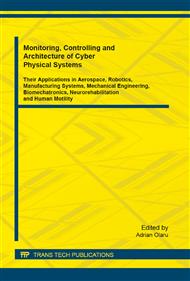[1]
C. Cristescu, C. Dumitrescu, L. Dumitrescu and I. Ilie, The dynamic behavior of the prehension mechanism of one transfer manipulator with electro-hydraulic acting, In: Applied Mechanics and Materials, vol 332, 2013, pp.165-170.
DOI: 10.4028/www.scientific.net/amm.332.165
Google Scholar
[2]
V. Muresan, M. Abrudean, Temperature modelling and simulation in the furnace with rotary hearth, IEEE International Conference on Automation, Quality and Testing, Robotics - Theta 18, pp.147-152 (2012).
DOI: 10.1109/aqtr.2010.5520900
Google Scholar
[3]
V. Muresan, M. Abrudean, Control system optimization of rotary hearth furnace charging/ discharging, 5th International symposium on Applied Computational Intelligence and Informatics, pp.277-282, (2009).
DOI: 10.1109/saci.2009.5136257
Google Scholar
[4]
Z.G. Zang, B.G. Zou, and Z.F. Bi, Dahlin algorithm design and simulation of time-delay systems, IEEE, pp.5819-5820 (2009).
Google Scholar
[5]
Z. Weidong, H. Xing, and X. Xiaoming, Comparison of several well-known controllers used in process control, In: ISA Transactions, no. 42, 2003, pp.1-9.
DOI: 10.1016/s0019-0578(07)60136-0
Google Scholar
[6]
Information on http: /higheredbcs. wiley. com/legacy/college/seborg/0471000779/dig_control/ch26. pdf.
Google Scholar
[7]
D.E. Riviera, M.E. Flores, Internal model control, Control systems, Robotics and Automation Encyclopedia of Life Support Systems (EOLSS), vol. II, Eolss Publishers, Oxford, (2004).
Google Scholar
[8]
Information on http: /tx. technion. ac. il/~dlewin/054414/LECTURE_11. pdf.
Google Scholar
[9]
Y. Hikichi, K. Sasaki, R. Tanaka, H. Shibasaki, K. Kawaguchi and Y. Ishida, A discrete PID control system using predictors and an oberver for the influence if a time delay, In: International journal of modeling and optimization, vol. 3, no. 1, 2013, pp.1-4.
DOI: 10.7763/ijmo.2013.v3.223
Google Scholar
[10]
A. Krolikowski, D. Horla, Discrete-time adaptive internal model control, International Conference on Circuits, Systems, Signals, pp.112-115 (2008).
Google Scholar
[11]
S. Bingulac, Discretization and continualization of mimo systems, In: Yugoslav Journal of Operations Research, no. 4, 1994, pp.27-34.
Google Scholar
[12]
V. Muresan, Industrial processes control – Guide, UTPress Publisher, (2011).
Google Scholar


